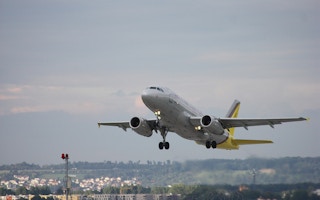The Paris Climate Agreement created a framework for keeping the global rise in temperatures below 2 degrees Celsius (3.6 degrees Fahrenheit) over pre-Industrial levels, but it left emissions from international flights and shipping in limbo – partly because their “international” nature made it hard to reach agreement on which countries to charge the emissions to.
That changed for one of those sectors on Thursday, when the International Civil Aviation Organisation (ICAO), the UN agency charged with coordinating aviation regulation, agreed to freeze net aviation emissions at 2020 levels beginning in 2021, and to force airlines to offset emissions above that threshold.
The agreement came just two days after the European Commission voted to ratify the Paris Climate Agreement, ensuring that it comes into effect on November 4 of this year – apropos, because if it weren’t for the Europeans threatening to impose their own regulations on all flights into and out of their part of the planet, we might not have this agreement.
The Market-Based Mechanism
The offsetting program, called “CORSIA” (Carbon Offsetting and Reduction Scheme for International Aviation), will be phased in over seven years, with a voluntary pilot phase running from 2021 through 2023, then a second voluntary phase from 2024 through 2026, and a final phase, running from 2027 through 2035 that is mandatory for all countries except the very poor.
ICAO President Olumuyiwa Benard Aliu said that 65 countries had already signed on for the voluntary phase, and these countries together represent nearly 83 per cent of total aviation miles, measured in “revenue tonne kilometers” (RTKs), which translate into one metric ton of load (human passengers or cargo) per kilometer traveled. The Environmental Defense Fund tracker says that CORSIA covers 65 per cent of emissions growth in Phase 1 and 79 per cent in Phase 2.
Like the Paris Climate Agreement, the new ICAO agreement sets a minimum threshold and offers a clear path for ratcheting up ambition; Dutch environmental attorney Jos Cozijnsen, a former climate negotiator for the Netherlands, said that once a country joins in the voluntary phase, it becomes a binding agreement.
“
This opens the door for the aviation sector to reduce its emissions in a way that reinforces the commitments in the Paris Agreement soon entering into force.
Gustavo Silva-Chávez, program manager, Forest Trends
“It’s voluntary to join, but if you’re in, you’re in,” he said. “It’s the same with the Paris Climate Agreement. All the NDCs (Nationally-Determined Contributions) are voluntary until you make them, and then they’re binding.”
Negotiators did not agree on what type of offsets will be recognised, but created a working group that will determine that by the end of 2018.
Capping routes, not countries
Under CORSIA, the emission caps will be applied to routes rather than to airlines or countries, and it will only apply to routes between countries that have joined CORSIA. For example: both the United States and China say they will join CORSIA from phase one, so all flights between the two countries will be subject to the cap per RTK from 2021 onward. Airlines will then have to pay based on a complex formula that takes into account their size and their overall emission increase.
A flight between China and an exempt country like Uganda, however, won’t have to offset its emissions, but it will have to account for them.
The European Impetus: An audio history lesson
The agreement may not have happened at all if the European Union hadn’t threatened to unilaterally impose restrictions on all flights entering the Eurpopean Economic Area, says Arjun Patney, policy director of the American Carbon Registry on the most recent edition of the Bionic Planet podcast.
Land-use initiatives
Several NGOs, including Ecosystem Marketplace publisher Forest Trends, have argued for the inclusion of offsets that reduce greenhouse-gas emissions by promoting sustainable agriculture and forest management.
“This opens the door for the aviation sector to reduce its emissions in a way that reinforces the commitments in the Paris Agreement soon entering into force,” said Gustavo Silva-Chávez, a Program Manager at Ecosystem Marketplace publisher Forest Trends.
“Airlines should meet their pledges by financing forest protection – providing an infusion of funding that will be critical to conserving the world’s forests.”
Although talks are closed-door, several sources said that such initiatives seemed to find considerable traction with airlines and negotiators from some countries, but there was less consensus on how individual forest-carbon projects might be incorporated into such an initiative.
Individual forest-carbon projects are effective in small areas, but they have one major weakness: namely, if the deforestation they prevent just ends up moving someplace else, then they haven’t actually reduced emissions; they just displaced it.
For that reason, the Paris Climate Agreement only has provisions for so-called “jurisdictional” approaches that cover entire countries, but many of the forest-carbon initiatives currently active are individual projects.
This story was published with permission from Ecosystem Marketplace. Read the full story.










